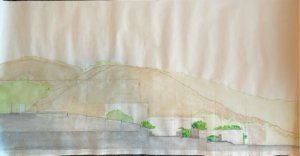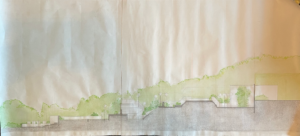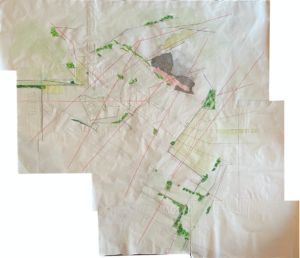The starting point for my project was the text Crime scene: Dallas, Texas, November 22, 1963, 12:30 p.m., an excerpt from the book In Space We Read Time: On the History of Civilization and Geopolitics by Karl Schlögel. This text is about that the notion of a historic event is mainly determined by the images that exist of that event, both visual and textual. This is how we, as humans, remember things that happening; we use the representations to retell the story.
Film is a medium that is used to visualize a time-dimension. This happens through a series of images, which presumes a certain order, or a sequence. Like with every image, they are framed; they are boxed in, and the edges determine the interpretation. Both together reminded me of a column I read about Simultaneity, written by Oscar van den Boogaard in De Standaard, as it also talks about time and space.
Years ago, a wise old man sitting across from me in the train from Geneva to Davos told me that time does not exist. Everything is present in the here and now, simultaneously. However, because people are such limited beings who can only perceive one thing at a time, they perceive things one after the other. Time is nothing but the spreading of things that are actually piled up.
According to him, we had already arrived in Davos when we got in in Geneva. But because mankind is not yet ready for that idea, we think we need the train. A film passes by behind our window, which, frame by frame, makes us believe that a distance has been traveled. Life is nothing but the time you need to experience everything that is present.
That thought made me smile.
‘You don’t believe me,’ he said reproachfully. ‘You think we just met, but I already knew you, I have always known you, even though I have forgotten your name.’
I looked at him wonderingly.
‘You are a writer, you have always been so, long before you could hold a pen, you should know what I’m talking about. A book is knowable in one glance. The whole story is in it. But it must be read first to get to know it. Word by word.’
‘The book may contain everything at once, but before it can be read, it must first be written.’
‘The writer writes down which already exists.’
‘So, I might as well not be writing,’ I said, bewildered. ‘All that work for nothing.’
‘You must write to make yourself and others aware of it. Because something that cannot be known, leads an invisible existence.’
‘Are you a writer as well?’
‘No, I’m a painter,’ the old man said. ‘I also make visible that which already exists.’ He got out in Davos and said: ‘You think I’m old, but we share the moment.’
The film that accompanied the text was Tourism International by Marie Voignier. The site that was mainly used in the fragment was the Martyr’s Cemetary in Pyongyang. Content-wise, this film was less interesting to me, because it mainly focusses on the fact that North Korea has a dictatorial regime, and that the view of the inhabitants and visitors will be determined by those in charge. Nonetheless, I was fascinated by the site itself and the architecture of it, so I looked for other footage of it. The video I ended up using for my one-minute site was made by an American tourist. What intrigued me about this clip was the fact that it was filmed as he was walking up the stairs and you’re seeing the things around him almost as he was seeing it. This meant that the video contained both the time- ànd the space aspect; he was moving through the site, looking around, turning.
My next step was to try to understand the site more, using only this video. I followed the gaze of the filmmaker as he’s looking around, spreading the image over the screen as if the site would really be there.
Then I used this as a guideline to reconstruct the image of the site, by making a collage of film stills. This created a 3D-view of an entirely new site. I traced new lines on this collage, as brackets to construct a new 3D view; because the filmmaker had moved through time and space, the same objects had been seen from different angles. One step was not just one step anymore, the busts that all have the same dimensions had mutated into individually different busts. By merging the collage (which was too much) and the line drawing (which was too constrained), a new site emerged, containing this multitude. Then it was up to me to make decisions and to re-constrain the image back to a clear 3D view, from which I would be able to build a new plan and sections.






